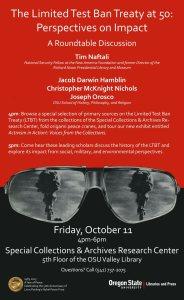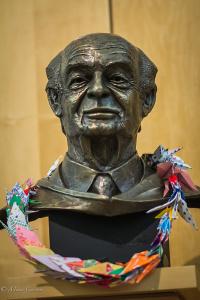
Bust of Pauling with a lei of peace cranes. Image courtesy of Mina Carson.
On October 10th, 1963, the Limited Test Ban Treaty came into effect, having been agreed to some two months prior by the United Kingdom, Soviet Union, and United States. On the same day, Linus Pauling received notice that he had belatedly won the 1962 Nobel Peace. To commemorate the 50th anniversary of these events, the OSU Libraries Special Collections and Archives Research Center sponsored a roundtable discussion on the impact and legacy of the treaty. The event was held in our reading room on Friday, October 11th.
The afternoon began with the opportunity to browse items from our collection directly related to the signing of the treaty. A table was also set up for attendees to fold origami peace cranes. Afterward, Christopher McKnight Nichols, Jacob Darwin Hamblin, and Joseph Orosco from OSU’s School of History, Philosophy, and Religion were joined by Tim Naftali of the New America Foundation to start the roundtable with brief comments before opening up a larger discussion that included an audience eager to weigh in on the issues surrounding the control of nuclear weapons.
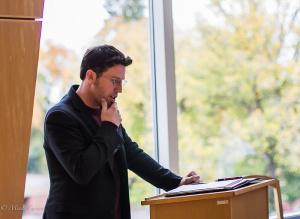
Christopher McKnight Nichols. Image courtesy of Mina Carson.
Christopher McKnight Nichols, Assistant Professor in History at OSU, began with a historical overview of international efforts to control nuclear weapons from their wartime use by the United States against Japan in 1945 to where the situation stands today. The first loud calls for banning the testing of nuclear weapons came in 1954 as fears began to rise about potential expanded use in theater as well as the dangerous effects of radiation. The Limited Test Ban Treaty of 1963 was the first international agreement affecting nuclear weapons. From there, activists’ goals broadened to include a comprehensive test ban that would, as Nichols stated, “ban nuclear testing at any time, at any place, by any state.” The reality of the 1963 treaty assumed a less ambitious form, banning only atmospheric and underwater testing, thus allowing for the continuation of underground tests.
Efforts in support of a comprehensive ban persisted into the 1970s and 1980s with little progress beyond the Threshold Test Ban Treaty of 1974 between the Soviet Union and United States, which banned the underground testing of bombs larger than 150 kilotons. For sake of comparison, the bombs dropped on Hiroshima and Nagasaki were roughly 15 to 20 kilotons in magnitude.
After the end of the Cold War, the push for a stronger, universal ban led to broader support for the Comprehensive Nuclear Test Ban Treaty, which came open for signature in 1996. Ratification of the treaty is still pending since it requires that all forty-four of the known nuclear powers sign on. So far, eight such countries have yet to do so: China, the United States, Egypt, Iran, India, Pakistan, Israel, and North Korea. Despite this lack of ratification, major nuclear powers including China, the United States, Russia, and the United Kingdom did agree to a moratorium on testing in the 1990s that is still in effect today.
Nichols concluded his remarks by suggesting that a ratified comprehensive test ban treaty may still be far away because, for some emerging countries, acquiring a place at the diplomatic table is viewed as tied to carrying out the testing of a nuclear weapon.
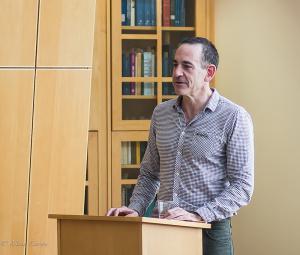
Tim Naftali. Image courtesy of Mina Carson.
Tim Naftali, who is National Security Fellow at the New America Foundation and former Director of the Richard Nixon Presidential Library, looked back at the circumstances surrounding the enacting of the Limited Test Ban Treaty in 1963. In June of that year, President John F. Kennedy met with civil rights leaders including A. Philip Randolph and Martin Luther King Jr. to acknowledge the impact that their efforts in the streets had made on his own decisions. Naftali pointed out that there was no equivalent recognition of the peace movement by Kennedy regarding the Limited Test Ban Treaty. This suggests that Kennedy perhaps did not need any push on these matters from people like Linus Pauling and, in supporting the treaty, was simply carrying on what was already in progress.
At the US-USSR Geneva Conference in 1956, President Dwight Eisenhower proposed an Open Skies Treaty. The agreement would allow for each state to fly its aircraft freely over the other’s land. Behind the scenes, the Soviet response was mixed. Soviet military leaders were in support, seeing it as great opportunity to close the intelligence gap with their chief rival. Naftali said that this assessment made Premier Nikita Khrushchev “furious.” Allowing the United States to fly freely over Soviet territory would expose the Soviets’ substantial weakness, which Khrushchev had spent so much time covering up through public bravado. Naftali compared Khrushchev’s posturing to that of a puffer fish that makes itself larger to deter predators. In the end Khrushchev prevailed, and the Open Skies Treaty was never signed. Not until the 1987 Intermediate-Range Nuclear Forces Treaty, under a more willing Mikhail Gorbachev, would the Soviets open up to onsite inspections.
By 1963 nuclear war emerged not only as a threat to the people of the Soviet Union and United States, but also to the respective ideologies of each country. While Khrushchev was confident in the orthodox Marxist historical progression that saw communism as the inevitable successor to capitalism, he was less certain that communism could survive a nuclear war, thus rendering efforts like the Limited Test Ban Treaty more attractive. Kennedy similarly saw nuclear war as the only real threat to realizing the American Dream, yet the development of nuclear weapons was still of value. The worth of the treaty, for Kennedy, was that it changed the rhetoric of U.S.-Soviet relations from that of enemies to one that was more businesslike, emphasizing, as Naftali described it, “competition on economic and social grounds, not on military grounds.” The success of the treaty, in this case, was defined by the diplomatic conditions that it helped to create and foster.
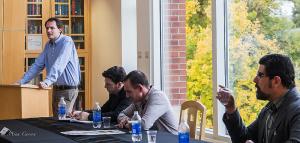
Jacob Hamblin at the podium. Image courtesy of Mina Carson.
Jacob Darwin Hamblin, Associate Professor of History at OSU, challenged the idea of looking at the Limited Nuclear Test Ban Treaty strictly in terms of its diplomatic significance. Health and environmental questions were central to efforts, like those of Linus Pauling, to ban nuclear testing before the treaty. By enacting the treaty, Hamblin said, these questions were obscured and even dismissed as the parties to the treaty no longer had to answer to allegations made by their own citizens or other countries who had no part in testing, but were still affected by fallout from the tests.
The treaty itself can easily be thought of as a recognition of the harmful effects of testing nuclear weapons. Yet the activity of the Soviet Union and United States in the year leading up to the ban – cognizant that their time to test weapons as they pleased was running out – saw a surge in the number of tests being conducted, with the United States carrying out 105 and the Soviet Union 138. For the United States this rash of testing included exploding bombs in the newly discovered Van Allen radiation belt, which extends 600 to 37,000 miles above the surface of the Earth. One atmospheric test, called Starfish Prime, created an electromagnetic pulse that knocked out power in Hawaii.
Environmental observers also looked on the UK’s “Big Freeze” winter of 1962-1963 as a possible consequence of the large amount of testing that had gone on just before the ban. Exploding large bombs in the atmosphere may indeed have had unexpected effects.
For the United States, the rationale behind continued testing was to act as a deterrent to the Soviet Union. But as Hamblin stated, other countries did not care about that rationale as the potential harm it could cause far outweighed any benefit the United States could have received.
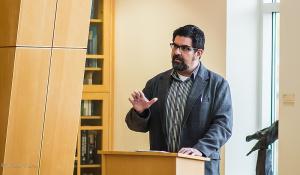
Joseph Orosco. Image courtesy of Mina Carson.
Joseph Orosco, Associate Professor of Philosophy at OSU, looked at the Limited Test Ban Treaty from yet another angle. According to Orosco, the treaty demonstrated the ability of ordinary people to pressure government leaders into action. While Kennedy himself may not have acknowledged the influence of the peace movement (as suggested by Tim Naftali) people close to him did. Jerome B. Wiesner, Kennedy’s science advisor, had said that groups like SANE, Women Strike for Peace, and Linus and Ava Helen Pauling in particular were very influential on Kennedy’s decision to support the treaty.
The significance of the peace movement did not stop with the treaty. In 1957 a group of Chicago Quakers formed a committee to stop nuclear weapons testing in hopes that it would bring together various pacifist groups. One step toward this goal was activity in support of what would become the Limited Test Ban Treaty of 1963. Because of the variety of people involved, two separate groups emerged: the Committee for Non-Violent Action and the Committee for a Sane Nuclear Policy.
The Committee for Non-Violent Action organized around Gandhian nonviolent resistance in order to change opinions about nuclear testing. The group’s tactics included putting themselves in harm’s way to highlight the tests’ dangers. In 1957 committee members broke into a Nevada test site. The next year members Albert Bigelow and George Willoughby attempted to sail from Hawaii to the Marshall Islands test site but were arrested before getting there.
These strategies, Orosco argued, would serve to influence later activist movements. Willoughby himself would become a nonviolent trainer and help start the Movement for a New Society in West Philadelphia, the goal of which was to demonstrate communal living under anti-racist and feminist values. The community developed general assemblies for use in consensual decision making, methods that became more important within non-violent movements during the 1999 World Trade Organization protests in Seattle and the recent Occupy movement as well.
The Committee for a Sane Nuclear Policy assumed greater prominence than did the Committee for Non-Violent Action because of its more direct educational and lobbying efforts. Norman Cousins, who was the group’s chairman, engaged in back door diplomacy between Kennedy and Khrushchev, meeting with both leaders individually to discuss nuclear policy. Cousins has been credited for pushing Kennedy to give his American University “Open Door” speech in early 1963, which has been seen as influential in prodding Khrushchev to agree to the Limited Test Ban Treaty.
For SANE a downside to working so closely with American and Soviet politicians was the consequent need to demonstrate to the American public that the group was free of communist sympathizers. This imperative ended up turning many people, including Ava Helen Pauling, away from the committee, as they saw the anticommunist activities as a major distraction from the group’s stated goal. This splintering led to the formation of separate groups like Women Strike for Peace that also prefigured later, more decentralized forms of social justice organizing up still influential to the present day.
For Orosco, the Limited Test Ban Treaty was successful in “organizing, energizing, and empowering” people to take control away from elites who had been leading the world toward destruction. Their efforts demonstrate the power of the people to help bring peace to the world.
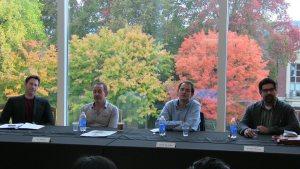
The panelists assembled on a beautiful fall afternoon in Corvallis.
After each member of the panel had finished presenting, the floor was opened to questions and comments from those in attendance. To start off, the discussion centered on the role and relevance of nuclear weapons in the present climate of international politics. Nichols downplayed any tactical benefits that could come from nuclear weapons for nations like the United States as a larger variety of weapons now available can fulfill tactical needs at far less cost in terms of international outrage. Where there is concern though, is among smaller states who have access to nuclear technologies but not other weapons.
Hamblin agreed, saying that nuclear weapons have been crucial regarding strategy but are not crucial at this moment for maintaining the position of the United States in the world. Because of this, Hamblin felt it more relevant to focus on banning other types of weapons that are used in current wars.
An audience member expanded on Hamblin’s point and asked if focusing on any type of weapon distracts from the underlying violence of war. Orosco responded that certain weapons have always been seen as “game changers.” These weapons have included the introduction of the crossbow in medieval times and, more recently, the use of chemical weapons in Syria. Perceptions of these weapons as being particularly dangerous are based on their capacity to destabilize the ruling social and economic order. Orosco suggested focusing on means to promote social and economic stability as ways to lessen the recourse to violence and promote peace.
Nichols offered another perspective, pointing out that “game changers” are often more indiscriminate and less targeted in their effects. Efforts to outlaw certain weapons have typically focused on a desire to protect civilians and establish agreements on lawful and unlawful warfare. Orosco noted that even Thomas Aquinas, the thirteenth century Catholic theologian, sought to justify the violence of war with his doctrine of double effect, which morally exonerated individuals who caused others harm if they did so for a greater end. With this, Orosco suggested that war itself is uncontrollable at any level and efforts to promote peaceful relations should be more prominent than those to lessen violence.
Once the more formal discussion ended, conversations continued around the issues raised throughout the event as people slowly trickled out the doors. So concluded the first in OSU’s year-long series of events commemorating Pauling’s Nobel Peace Prize.
